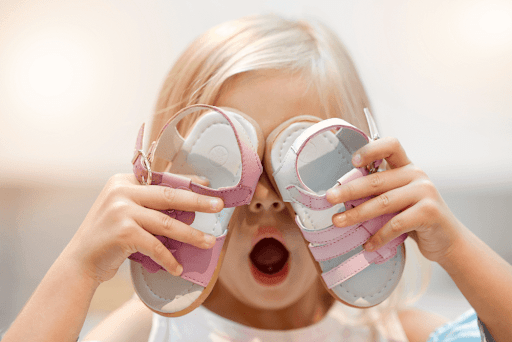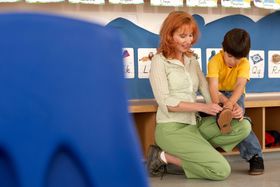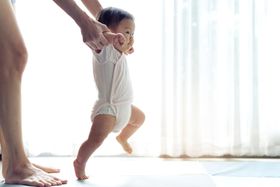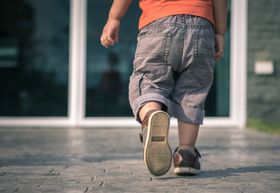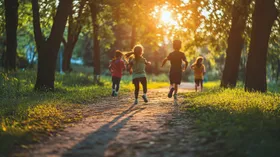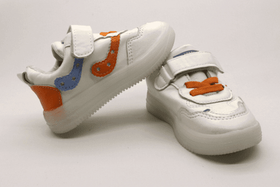Blisters on Infants' & Toddlers' Feet: Causes & Prevention
Tiny feet, big problems? Understand why blisters appear on your little one's feet and learn how to prevent them from forming
Published January 9, 2025.
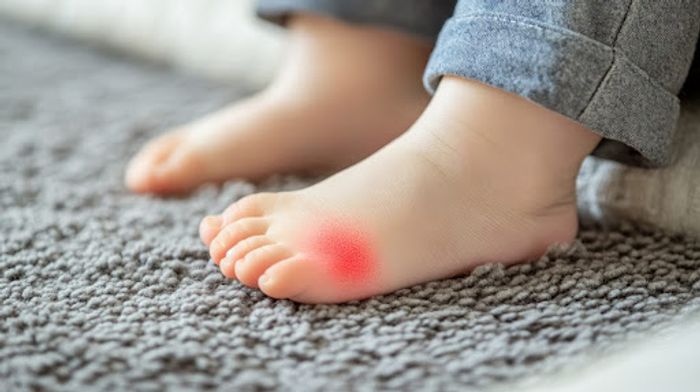
From first steps to playground sprints, your child's feet are their gateway to discovering the world. But when blisters strike, they can put a painful pause on all the fun.
Whether you're dealing with your crawler's first friction spots or your preschooler's active-play blisters, we've got you covered with expert advice.
» Say goodbye to blisters with supportive kids shoes for all ages
Understanding Blisters on Kids' Feet
Blisters arise when the top layer of skin (epidermis) separates from the deeper layers, forming a fluid-filled pocket. This fluid, known as serum, acts as a natural cushion, protecting the delicate underlying skin while nourishing it with growth factors and nutrients to accelerate healing.
Because children's skin is thinner and more delicate than adult skin, it is particularly prone to blister formation. This vulnerability is heightened in areas of frequent contact with footwear or surfaces. Kids may not communicate discomfort effectively, so parents must be watchful for early signs of skin irritation.
The causes and impact of blisters vary significantly between infants and toddlers. Pre-walking infants often develop blisters due to prolonged pressure while lying down or crawling. Meanwhile, active toddlers are more susceptible to friction-induced blisters from walking, running, and playing.
» Explore how to choose kids' shoes for different stages of development
Common Causes of Foot Blisters
Several factors can contribute to blister formation in young children. Understanding these causes helps parents take appropriate preventive measures:
- Improper Footwear: Too-tight shoes create pressure points that lead to painful blisters. Meanwhile, loose shoes allow excess movement that causes friction against the skin and can lead to persistent rubbing in specific areas.
- Environmental Conditions: Excessive moisture from sweaty feet or wet conditions can soften the skin and make it more susceptible to friction damage and blister formation. This is especially true during hot summer months or intense physical activity.
- Sensitive Skin: Conditions like eczema or dermatitis can make children more prone to blisters, as their skin may be more delicate and reactive to pressure or friction.
- Activity Level: Movement patterns affect blister formation. For example, crawling babies experience friction in different areas compared to walking toddlers. This requires age-appropriate protective measures.
» Learn more about the effects of improperly sized shoes on children
Tips For Preventing Blisters in Kids' Feet
Taking a proactive approach to blister prevention requires a comprehensive strategy:
- Inspection: Make regular foot checks part of your routine. Look for early warning signs like redness, warm spots, or areas that seem to be rubbing against shoes. Pay special attention after your child gets new shoes or during active periods like sports seasons.
- Moisture: Keep feet dry by changing socks frequently, especially after active play or in hot weather. Consider moisture-wicking insoles during high-activity periods or warm seasons. Avoid plastic or rubber shoes that trap heat and sweat.
- Protection: Apply specialised foot powders or appropriate moisturisers to maintain healthy skin. For areas prone to friction, consider using petroleum jelly or barrier creams before long periods of activity.
- Socks: Select moisture-wicking materials like merino wool, bamboo, or cotton blends rather than synthetic fabrics. Seamless socks reduce irritation points, and cushioned areas at heels and toes provide extra protection. Make sure socks fit snugly without bunching.
- Footwear: Well-fitted shoes are perhaps the most crucial factor in preventing foot blisters. They ensure proper foot alignment, enabling natural movement and creating a healthy environment. This reduces friction and fatigue, minimising the risk of blisters.
» Understand how choosing the right footwear helps prevent injuries
Essential Features to Look For in Shoes
When selecting shoes for your child, look for these crucial features that help prevent blisters:
- Flexibility: Flexible soles that bend easily at the ball of the foot, allowing natural movement while walking or running and reducing the likelihood of friction points developing during active play or daily activities.
- Ventilation: Breathable upper materials such as leather promote proper air circulation. This helps maintain optimal temperature and moisture levels inside the shoe throughout the day.
- Construction: Seamless interior construction eliminates potential friction points that could lead to blister formation, which is particularly important for children with sensitive skin or those prone to friction injuries.
- Adaptability: Adjustable closures like Velcro straps or laces enable precise fitting throughout the day, as feet can slightly swell during activity and require adjustment for optimal comfort.
- Stability: Non-slip soles provide excellent traction and stability, preventing the shoe from sliding around on the foot. This minimises internal friction and the risk of blisters, especially during active play.
Tip: Many parents find that rotating between multiple pairs of shoes can help prevent blisters and extend the life of footwear. This practice allows shoes to dry completely between uses and provides options for different activities.
Treatment for Different Types of Blisters
When blisters form, proper treatment is essential for quick healing and preventing complications. Here's a detailed approach to different types of blisters:
Small, Unbroken Blisters
Small blisters that haven't broken open require minimal intervention. Keep the area clean and protected from further friction. Monitor the blister for improvement or deterioration, and adjust footwear to prevent pressure on the affected area.
» Check out these tips every parent needs to know about foot care
Large or Painful Blisters
More prominent blisters that cause significant discomfort require more careful attention. Consider the following treatment steps:
- Clean the area thoroughly with mild soap and water, taking care not to break the blister if it's still intact. The fluid inside provides natural protection against infection.
- Apply an appropriate-sized blister pad or moleskin dressing that extends beyond the blister edges to prevent friction on the borders of the affected area.
- Monitor the blister daily for signs of healing or complications, and keep the area as dry as possible during the healing process.
- Document the location and circumstances of blister formation to help prevent future occurrences through adjustments to footwear or activity modifications.
Parents may be tempted to pop a blister in an attempt to relieve pressure, but this can increase the risk of infection and should be avoided.
» Keep moisture away with our breathable sandals for kids
Broken Blisters
Breaking the skin's protective barrier allows bacteria to enter, potentially leading to illness and prolonged healing. If a blister has broken, proper care is crucial to prevent infection:
- Clean the area with an antiseptic solution and remove any loose skin that might cause additional irritation.
- Apply an antibiotic ointment and cover with a sterile, non-stick dressing that allows the skin to breathe while protecting against contamination.
- Change dressings daily or more frequently if they become wet or soiled, constantly checking for signs of infection during dressing changes.
If you notice any signs of infection, such as redness, swelling, warmth, pus, fever, or increasing pain, consult a doctor immediately.
» Check out the difference between regular and supportive shoes
Say Goodbye to Blisters
Your child's early years are a time of incredible growth, and their feet are no exception. Protecting their feet is essential to ensure they can play, learn, and grow freely. Blisters can cause significant discomfort and even impact their desire to move and explore.
Choosing the right footwear is crucial, not just for blister prevention but also for supporting healthy foot development. Quality shoes should combine comfort and support, allowing your child to move freely and confidently.
First Walkers specialises in creating comfortable and supportive footwear for little feet. Their shoes feature enhanced ankle stability for confident steps, flexible soles for natural movement, and breathable materials to keep feet cool and dry. Let your child experience the joy of comfortable and supportive footwear with First Walkers.
» Protect your little explorer's feet from blisters with First Walkers
Disclaimer: First Walkers' information is intended for educational and informational purposes related to toddler footwear and feet. We encourage you to consider individual circumstances and consult qualified orthopaedists about specific conditions.
